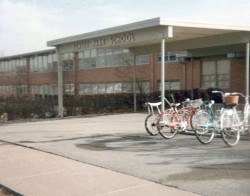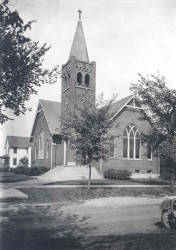Address: 2 W. Busse Avenue
Built: 1912
Demolished: 2006
What is currently at that address: Blues Bar
2 W. Busse has ties to a number of important businesses and people in the history of Mount Prospect. It was built in 1912 and was used as the home of William Busse’s Hardware store. When it was built, Mount Prospect did not have electricity or indoor plumbing. The village was not to be incorporated for another five years and there wasn’t a foot of paved road in town. The population was still predominantly German and tied to railroads and the farms. This store established the Busse family as a commercial interest in Mount Prospect and helped to put Mount Prospect on the map. The building was constructed by hand by local tradesmen and is the oldest brick building standing in Mount Prospect.
Originally the building had a flat façade with simple geometric brick design along the cornice. Later, in 1928 an addition was put onto the front of the building over the original two central windows on the second floor that extended about two feet out from the front of the building and peaked about three feet above the roof line. This new façade was built with half timbered design and was meant to match the building next to it that had been built in 1927.
William Busse’s Store grew rapidly from its opening and was soon selling farm implements and all sorts of goods. In fact, before the building was even completed, it became the first car dealership in town. The story is that William Busse was in Chicago in 1908, walking down Michigan Ave with one of his business partners, Barney Franzen. They passed by a Buick dealer and became fascinated by a car in the window. William Busse was interested in the car but was a little cautious. He and his business associate agreed to go into it together. They each bought one of the cars and William Busse was thrilled with it. Two years later he decided to upgrade from a two to a four-cylinder car and went back to the Buick dealer. He was so impressed by the car that he contacted the manufacturer and told them that he was interested in becoming a local agent. He was informed that the dealers in Chicago had agreements that covered the entirety of the county. Two years later, while William and his son Albert were on the roof of the 2 W. Busse building, laying the last of the shingles, a stranger climbed up the ladder. It turned out that this man was a Buick representative and that he had come to offer William Busse a local agency for selling Buicks. He brought the paper work with him and William Busse jumped at the opportunity. He signed the paper work right there on top of the roof and Busse Buick was born.
At first the dealer ship had no garage. They would display the new cars on the street in front of the hardware store and at night they would roll them into the back of the store. In 1915, they built a cement block structure next door and began to offer full service repairs. In 1918 they built a new garage on 30 S. Main Street. They expanded this location in 1921 and it was finally complete in 1928. A year earlier the cinderblock structure was demolished to build the building that is today next door.
In that same year, Busse’s hardware store was dissolved. The Buick dealership became independent, the farm implement business was sold to the Meyn family, and the hardware store was sold to Frank Biermann and became Busse-Biermann Hardware.
In that year, the Mount Prospect State Bank took over the building and used it for a number of years. The Mount Prospect State Bank was one of the most influential businesses in the development of Mount Prospect. The bank was formed in 1911, originally as a national bank. It became a state bank in the 1920s because of a need for more flexibility in real-estate loans and other services. It was originally located in a small building on the northeast corner of Busse and Main, which later became the Mount Prospect Public Library, a delicatessen, and a real estate office before it was demolished in the 1960s. William Busse, the most influential person in the development of the community, founded the bank and used it as the financial backbone of his developments. In 1928 at the height of the boom of the 1920s, the bank moved from its original building to the larger building at 2 W. Busse. In this location the bank weathered the Great Depression of the 1930s and was one of very few financial institutions to go through the depression without willingly closing its doors. The exception to this took place in 1933, shortly after the inauguration of President F. D. Roosevelt, all banks in America were ordered to close and work out their books. The Mount Prospect State Bank closed its doors for the first time. However, it was one of the first banks in Illinois to reopen in a time when only a fraction of the area’s banks ever reopened. Mount Prospect’s resolve and financial discipline in this time, all of which was made possible through the work of the Mount Prospect State Bank and William Busse from his office at 2 W. Busse, is one of the great defining stories of the community.
The bank then worked through the Second World War from its location on Busse Avenue. Following W.W.II, Mount Prospect went into its largest building boom ever and the State Bank was there to finance it. Between 1950 and 1960 Mount Prospect’s population grew by almost 500%. Many of the homes were built by returning GIs who went straight to 2 W. Busse to finance their new homes and open a bank account. The bank at this location was the largest savings bank in Mount Prospect and a center in the community. Finally, in 1967 the Mount Prospect State Bank decided it needed to move again to a larger location. They built the building that later became the Mount Prospect Village Hall and was recently demolished. The building that the bank left behind proved to have much more resilience than the new one that was built. It later became an ice cream store, the home of Roller Derby legend, Sammy Skobel’s Hot Dog’s Plus, a Mexican restaurant, a pizza place, and today an Italian restaurant.
Let us know about what you remember from this building. We will include your thoughts in our research files and may put them on-line as a part of our structural memorials.

